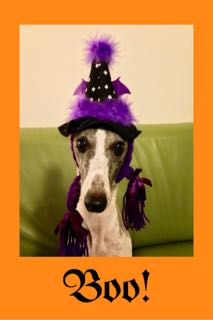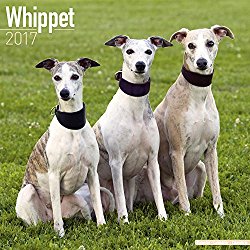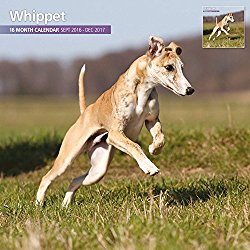| Back to Back Issues Page |
 |
|
The Whippeteer: Whippet Dog News, Issue #72 - Leash Training October 31, 2016 |
Keep Your Whippet WarmWhippet Coat
Ancol Med Whippet Coat 17" length The Muddy Paws Whippet Dog Coat is specially designed to fit your whippet or greyhound perfectly both before and after racing and during exercise. The coat is very easy to adjust using the velco strap that wraps around your dog's belly. The neck of the dog coat extends further than a regular dog coat, helping to prevent water from running down your dog's neck. For extra warmth the coat has a faux sheepskin lining, leaving your dog cosy and warm.
HighlightsShare your Whippet Pics! Make your whippet a star for a day (or longer) by entering a picture in the Dog of the Day and see your pooch in our homepage!
News and ArticlesRadish The Ball-Bopping Whippet 14 Reasons Whippets Are The Worst Indoor Dog Breeds Of All Time Four basic rules for walking dogs in coyote territory I am not a Dog Park advocate. The Dog Show Game – Telling It Like It Is The Calming Signals Most Humans Miss From Their Pets Naturally Fearful Dogs A Designer Dog Maker Regrets His Creation Glenn Gregory says whippets are Heavenly CPR and First Aid For Animals Study: Dogs Can Identify Liars, and They Don't Trust Them Whippet Art
A Whippet Dog art portrait print of an LA Shepard painting 8x10" Featured ArticleHow To Train Your Dog To Walk On A Loose Leash
Leash training your dog is an excellent way to strengthen your position as the one in charge. You need to train your dog to walk on a loose leash, so that you and your dog can both enjoy the walk. A tight leash means a much harder time controlling your dog (unless you are the one that is making the leash tight; in which case you're going to have a much harder time both enjoying the walk, and teaching your dog what you want). Here are five tips to help you leash train your dog. TIP 1: HAVE THE ATTITUDE OF A LEADER Dogs are experts at reading body language. Use your body to communicate with your dog that you are the one in charge, by holding your body the way a natural leader would hold her/his body, while you are walking with your dog. Hold the thought in your mind that you are in charge. Don't prove to your dog that you are in charge. Instead, communicate to your dog that you are in charge through attitude. TIP 2: RELAX With your dog on your left side, take hold of the loop end of the leash with your right hand.. Grab the leash loosely with your left hand, leaving slack in the leash between you and your dog. A loose grip is essential here as it allows you to stay relaxed, and gives you more freedom to make adjustments as you walk. You should be able to swing your arms naturally while walking your dog. This will reduce both your mental and physical stress levels, allowing you to enjoy the walk. And, the more you are relaxed about the walk, the more relaxed your dog can be, allowing it to enjoy the walk, while still being under your control. Think of your dog as just an extension of your arm; wherever you go, it must go, just as any part of your arm must go. TIP 3: CHANGE DIRECTIONS OFTEN By changing your direction of travel when your dog is not expecting it, you will teach your dog to pay better and better attention to you. Changing direction is also the best way to stop a dog from pulling. If your dog is unaccustomed to walking on a leash, it will probably immediately start out faster than you, and start to pull. This is where your timing becomes critical. As soon as your dog starts to get out ahead of you, and before it gets to the end of the leash, quickly back up or turn around. Timed correctly, your dog will get no chance to pull, your arms will stay relaxed, and your dog, as an extension of your arm, will be pulled into a different direction with little effort on your part. Continue to change directions every time your dog is about to pull, and it will soon learn that pulling is not an effective way to get where it wants to go. TIP 4: USE POSITIVE REINFORCEMENT You need to reinforce your dog for walking on a loose leash, and you need to do it a lot. This is how I reinforce loose leash walking: If the dog is walking on a loose leash, and not trying to get ahead, but not really paying attention to me, I praise it heavily. I might even reach out and pat it on the shoulder. I do everything that I can to let it know that it is doing well. I do the same if the dog checks in with me by looking at me, even if it is out ahead a little farther than I would like, or off a little too far to the side. However, what I really want is to have the dog pretty much next to me, and to be checking in with me frequently. So, as soon as the dog is next to me, and it looks up at me at the same time, I tell it "Yes," and pop it a treat, I also often give the dog a pat on the shoulder while giving it the treat. I want to make it feel that walking next to me, and paying attention to me, is the best thing ever. TIP 5:
INITIALLY, PRACTICE IN A DISTRACTION-FREE AREA
Teaching your dog to walk on a loose leash will go a long way in teaching your dog that you are in charge. Soon, you will be able to really enjoy your walks knowing that your dog is going to walk nicely. You will then be able to notice all of the wonderful things going on in the world around you. Have fun! Sue Skiff is a dog trainer, and dog behavior specialist, with over fifteen years experience. For more information on dog training and behavior please visit her information website. This site has dog training tips, information on curbing common behavior problems, and a blog containing training tips and animal stories. If you are looking for a complete guide on how to train your dog so that it will always be well-behaved, you can read How to have a Well-Behaved Dog, Sue's e-book, here. Article Source: https://EzineArticles.com/expert/Sue_Skiff/1244041
Visit the TheWhippet.net frequently as we are constantly updating our site with information, resources and tips for the dog lover. I would like to thank here all our readers whether they are regular visitors or new to the site and especially all the contributors to our pages. They all made my job more rewarding and our site more interesting for everyone.
All your contributions are really appreciated! Visit us soon at TheWhippet.net! |
| Back to Back Issues Page |


